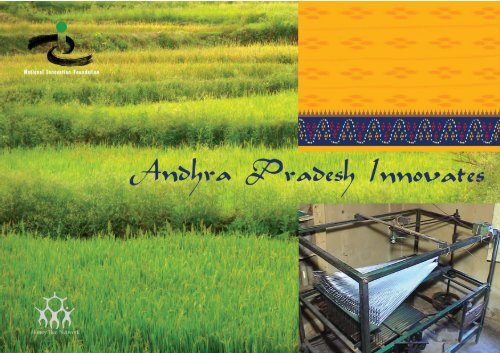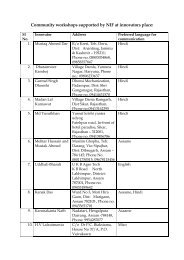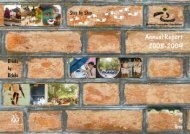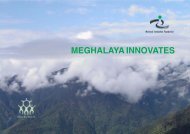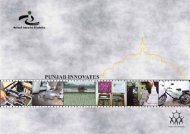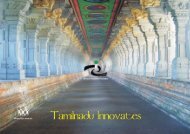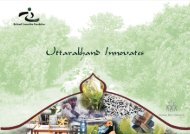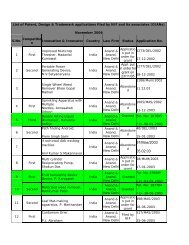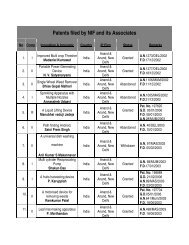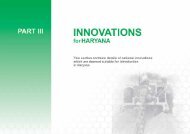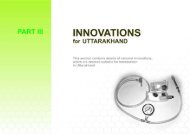PART-I Andhra.pmd - National Innovation Foundation
PART-I Andhra.pmd - National Innovation Foundation
PART-I Andhra.pmd - National Innovation Foundation
- No tags were found...
Create successful ePaper yourself
Turn your PDF publications into a flip-book with our unique Google optimized e-Paper software.
PREFACE<strong>National</strong> <strong>Innovation</strong> <strong>Foundation</strong> (NIF) has been pursuing themission of making India innovative and a creative societysince 2000 with the active support of Department ofScience and Technology, Government of India. Till dateNIF has been able to scout innovations and traditionalknowledge practices from over 545 districts across India.Thanks to the support of volunteers from Honey Bee Network,we have been able to discover many unsung heroes andheroines of our society who have solved local problemswithout any outside help.Despite various constraints, NIF has put together a small bookcelebrating creativity, innovation and traditional knowledgefrom <strong>Andhra</strong> Pradesh. I am conscious of its limitation in termsof coverage and outreach. But if we could uncover so manyexamples of the ability of local communities and individualsto solve problems on their own without outside help, howmuch more can be done if state and private sector agenciesjoin hands with NIF actively.I invite the state government and its various organs toactively support our quest to uncover many more creativecommunities and individuals in rural and urban areas. NIFwill then help in building value chain around them.The book is divided in three parts. The mechanical innovationsdeveloped by innovators from <strong>Andhra</strong> Pradesh are coveredin part one. Selected examples of herbal traditional knowledgeare given in part two. The innovations from other parts ofthe country suitable for the development of <strong>Andhra</strong> Pradeshare given in part three.By no stretch of imagination, could we claim that we haveachieved a great deal. We have merely made a simple point.There are a large number of knowledge rich people whoANDHRA PRADESH INNOVATES 4
ANDHRA PRADESH INNOVATESmay not have been educated much, may in fact beeconomically poor also, but still have the ability to solvea few problems so well.The challenge really is to work out a synergy so that nocreative voice remains unheard, and no solution remainslocalized and unrecognized. By adapting public policy insupport of grassroots innovators and traditional knowledgeholders, we can make economic development processmore inclusive and sustainable.This book on innovations has been compiled at the requestof Dr. Vijay Kelkar, Chairman, Finance Commission and theMember, Governing Council of the <strong>National</strong> <strong>Innovation</strong><strong>Foundation</strong> as a tribute to the creativity and innovation atgrassroots. This presentation is part of a series of innovationcompendium prepared for every State of India. We hopethis will be followed up in the form of concrete policy andinstitutional initiatives in each State to empower creativepeople to improve the quality of life of common people andthus promote inclusive growth.It is my belief that such examples will act as spur for otherState government departments to look for creative efforts oftheir staff and users at ground level. I hope that NIF willhave the opportunity to work closely with the State governmentin future and expand knowledge base, add value to selectedtechnologies and help them diffuse through commercial andnon-commercial social channels for improving the livelihoodof the majority of the people.R. A. Mashelkar, FRSChairperson, Governing Council<strong>National</strong> <strong>Innovation</strong> <strong>Foundation</strong>, Ahmedabadmashelkar@nifindia.orgANDHRA PRADESH INNOVATES 5
ANDHRA PRADESH INNOVATESdevelopment, (c) Business development and Micro Venture, (d)Intellectual Property Rights protection and (e) Dissemination,database development and IT applications.NIF has been entrusted with the responsibility of building a<strong>National</strong> Register of Grassroots <strong>Innovation</strong>s and TraditionalKnowledge. It is not enough to document or disseminate theinnovations or outstanding traditional knowledge. Value additionis very important for harnessing the full potential of the idea.NIF has entered into MOU with CSIR and Indian Council ofMedical Research (ICMR) besides other organizations. CSIRhas allocated funds to support research on grassrootsinnovations in CSIR labs. Similarly, ICMR supportsresearch on such herbal healing knowledge, whichhas not been documented in the classical texts and formalinstitutional literature. NIF also helps in generating a very largepool of open source / public domain technologies. A smallnumber of innovations are also protected by patents andother IPRs.For most innovators, attracting risk capital for convertinginnovations into enterprise is very difficult. They neither canoffer much collateral nor are they able to develop a businessplan or deal with formal R&D system.A Micro Venture <strong>Innovation</strong> Fund (MVIF) has been set up withthe help of SIDBI to provide risk capital for technologies atdifferent stages of incubation. Under single signature, innovatorsare trusted and investments are made to help them commercialisetheir innovations. Most innovators do not make good entrepreneurs.For entrepreneurship, one has to make consistent batch bybatch production of products. Innovators are often incorrigibleimprovisers. They seldom make two things alike. NIF has helpedsuch innovators to license their technologies to third partyentrepreneurs. Most of the licenses have been given to smallentrepreneurs and in a few cases, to medium enterprises.A very elaborate benefit sharing system has been developed,governed by the Prior Informed Consent (PIC) of the knowledgeThe Honey Bee Network strongly believes in sharing knowledge among theproviders of innovations in their own language, which is achieved by publishinglocal language versions of Honey Bee newsletter. It also ensures that a fairshare of benefits arising from commercial exploitation of local knowledge andinnovations reaches the innovators and knowledge providers.ANDHRA PRADESH INNOVATES 7
“<strong>Innovation</strong> opens up new vistas of knowledge and newdimensions to our imagination to make everyday life moremeaningful and richer in depth and content”.- Dr. A.P.J. Abdul Kalam“By adapting public policy in support of grassroots innovatorsand traditional knowledge holders, we can make economicdevelopment process more inclusive and sustainable”.- Dr. R.A. Mashelkar
01<strong>PART</strong> I : INNOVATIONS FROM ANDHRA PRADESHAsu making machine for Pochampally sareesC MalleshamNalgondaUsually, the process of making a ‘tie and dye’ silk saree in Pochampally tradition beginswith the selection of silk thread. In the process of Asu, the threads are tied to a triangularstand and designs are drawn on this stand. Tying is done where required as per thedesign and the threads are then dyed in selected colours. Once dried and untied, thedyed silk threads are rolled into spindles. The spindles are used appropriately in loomsand the saree is woven. The Laxmi Asu machine by Mallesham has relieved womenfrom 8-9 hours of labour everyday. The machine will help weavers save time as it justtakes 90 minutes to weave a saree with the machine as compared to the four hoursrequired in the manual process. This has brought a revolution in the weaver community.The Indian Patent has been filed for the <strong>Innovation</strong>. The innovator has sold more than500 units of the same.Also see Honey Bee 19(3): 4-6, 2009 for his detailed profile.ANDHRA PRADESH INNOVATES 12
<strong>PART</strong> I : INNOVATIONS FROM ANDHRA PRADESHANDHRA PRADESH INNOVATES 13
02<strong>PART</strong> I : INNOVATIONS FROM ANDHRA PRADESHRelighting fused tube lightsNarsimhachary while on a visit to the electricity department saw a huge pile of fusedtube lights. He decided to make use of this otherwise ‘waste resource’. He worked hardwith determination and found a cheap and viable solution for relighting the fused tubes.He went a step ahead in eliminating the choke and starter by introducing a simple andeffective circuit.M NarsimhacharyNizamabadHis innovation comprises a small PCB and one meter wire that can be easily connectedto the ends of the tube light by any person. A patent application also has been filed byNIF on his behalf. NIF also supported him under the Micro Venture <strong>Innovation</strong> Scheme(MVIF) for commercialization of his technology.Municipality of Nizamabad town is using his services for the last two years and hasaccrued substantial savings. Many villages, nearby and far, are approaching him forsupply of his kit in hundreds. Five more municipalities of the state and a few from MPand Karnataka have also approached him for supply of sizable number of kits.ANDHRA PRADESH INNOVATES 14
<strong>PART</strong> I : INNOVATIONS FROM ANDHRA PRADESH03‘Kodisa’ for Controlling Rice Hispa: A Grassroots<strong>Innovation</strong> Valued GloballyRice hispa is a dreaded plant disease that causes immense loss of rice yield in Southand South East Asia. Maniam Sitaraman, a tribal farmer from <strong>Andhra</strong> Pradesh in India,has been practicing biological control of rice hispa pest (Dicladispa armigera) throughhis innovative use of a poisonous plant, for over a decade with effective results. Thisplant locally called ‘kodisa’ (Cleistanthus collinus), is found abundantly in forest area, allalong the Eastern Ghats. He learnt the use of ‘kodisa’ from his father, a cattle rearer byprofession, who was a repository of knowledge on poisonous plants. However, atraditional practice of using crushed leaves of the plant had been in use for quite sometime, by the Khoya tribe of <strong>Andhra</strong> Pradesh, to which Sitaraman belongs. The pastemade out of leaves is used as an external application to cure ulcers on animals andhumans. Further the pulp of the bark is used to treat wounds of domestic animals.Maniam SitaramanKhammamSitaraman first learnt about the pesticidal property of the plant when he noticed dead ricehispa larvae along the water channel in paddy fields where the leaves of the plant werefloating. Since then he started putting cut branches of this plant in his rice fields andobserved that the damage caused by rice hispa pest had considerably reduced. Thecost of controlling the pest has also gone down compared to the cost of chemicalpesticides for which he used to spend Rs 1000 per acre.Although there exists ample scope of developing it in to an herbal pesticide, Sitaramanadmits the main constraint in using this innovative technique is that it is effective onlywhen used in the early stages of disease incidence (Honey Bee: 11(2) 7, 2000).ANDHRA PRADESH INNOVATES 15
04<strong>PART</strong> I : INNOVATIONS FROM ANDHRA PRADESHPedalling for ProsperityThe tribal farmers in Bhadrachalam area face severe difficulties in lifting water forirrigation, because of the unreliable supplies of fuel and electricity. Even in the areaswhere supplies are reliable, it is difficult for them to afford the ever-increasing cost offuel. Concerned with these problems, Ganeswara Rao developed some efficient andlow-cost pumps which can be operated manually.P Ganeswara Rao*(i) Hand-wheel pumpThis pump can be operated by turning a gear with hand. A person can sit over it whileoperating. Water can be pumped over to a height of 40 to 50 feet. To irrigate a three acrepaddy field, one has to run this pump for eight hours. It costs around Rs 4000 and weighsabout 20 kg.(ii) Water-wheel pumpA water-wheel pump does not need any manual labour. It uses the flowing force of astream to run itself. It can be fixed in any flowing stream having minimum two feet depthof flow. Depending on the velocity of the stream, it can pump water to a height of 50 to 90feet. It can irrigate a three acre paddy field in a day. The pump costs around Rs 7000.When the flow in the stream is not sufficient to run the pump, it can be used as a handwheelpump.(iii) Pedal-wheel pumpIt is similar to hand or water-wheel pump with an added advantage of pedals. A personcan operate it while sitting over it. Water can be pumped over to a height of 25 feet. Asecond person can also join in to run the other pedal. Water can be pumped up to 50feet using both pedals at the same time. The pump costs about Rs 5500 (*See HoneyBee, 8(1):16, 1997).ANDHRA PRADESH INNOVATES 16
<strong>PART</strong> I : INNOVATIONS FROM ANDHRA PRADESH05Reviving Dyeing SkillsC V Gopal Raju took up the task of stemming the erosion of skills of artisans of his village(Etikoppaka, distt. Visakhapatnam) who were beginning to migrate to urban areas towork as unskilled labourers. By starting a cooperative association called PadmavatiAssociates he sought to strengthen local traditions in making vegetable-based dyes. Hehas also developed new toys for which market is slowly emerging in India and abroad.Raju drew the attention of artisans to the declining supply of raw materials for themanufacture of vegetable dyes. With the initial support from the <strong>National</strong> Tree Growers’Cooperation and the Forest Department of <strong>Andhra</strong> Pradesh Etikoppaka VanaSamrakshana Samiti (Forest Protection Committee) was established few years ago. Ithas tried to conserve those species of plants that are used for making dyes. The committeeis protecting over 120 hectares of the forest land and several thousand ankudu (Wrightiatinctoria) tree saplings were planted by them.Raju has helped conserve traditional knowledge and consequently the associatedbiodiversity as well. He has also augmented thetraditional knowledge base throughcontemporary technical processes andinstitutional innovations. NIF also supported himunder the Micro Venture <strong>Innovation</strong> Scheme(MVIF) for the commercialization of histechnology. He won the State award in NIF’sSecond <strong>National</strong> Competition for Grassroots<strong>Innovation</strong>s and Traditional Knowledge in 2002(Also see Honey Bee, 8(3):3, 1997).ANDHRA PRADESH INNOVATES 17CV Raju*Vishakhapatnam* Though awarded earlier,the innovator is aprofessional as per thepresent rules of NIF, whichwere redefined tospecifically focus oninnovations from the peopleof unorganised sector.
06<strong>PART</strong> I : INNOVATIONS FROM ANDHRA PRADESHWind-Blowing InventionSatyanarayana has always been interested in inventing simple, low-cost appliances forthe middle and the lower classes. He has innovated a micro-windmill-driven batterycharger. This device harnesses wind energy to generate sufficient electrical potential torecharge batteries of cellular phones, Walkmans, palmtops, laptops, etc. He studiedscience and thus knew about various principles of energy and their applications.N V Satyanarayana*VisakhapattnamThe windmill is 3.5 x 3 centimetres wide. It produces direct current flow of up to oneampere at a potential difference of 12 volts. The current generated is sufficient to operatemost of the portable electronic devices which are currently operated with the use of drycell batteries. The mass production of the micro-windmill and promoting its use amongthe traveling public that uses electronic gadgets will help to conserve energy resources.He won a <strong>National</strong> award in NIF’s Second <strong>National</strong> Competition for Grassroots<strong>Innovation</strong>s and Traditional Knowledge in 2002. NIF also filed a patent for this innovationin the innovator’s name.* Though awarded earlier,the innovator is aprofessional as per thepresent rules of NIF, whichwere redefined to specificallyfocus on innovations from thepeople of unorganisedsector.ANDHRA PRADESH INNOVATES 18
<strong>PART</strong> I : INNOVATIONS FROM ANDHRA PRADESH07The Mail WomanSwetha is very keen to find solutions for the day-to-day problems occurring in the lives ofordinary people.While studying in the twelfth standard she developed a blueprint for postbox alarm. It isenvisaged as a simple device attached to a letter box which gives an audio or visualalarm as soon as something is dropped in the letter box. This can be effective for bigfarms or multi-storeyed houses, where the letter box is usually placed at the farawaymain entrance and the letters are collected only when someone is getting into the houseor the farm. It can also be helpful in normal houses when one is eagerly waiting for aletter from a loved one and does not know when the post will come!B SwethaWarangalHer idea won her an Award in the students’ category in NIF’s Second <strong>National</strong>Competition for Grassroots <strong>Innovation</strong>s and Traditional Knowledge in 2002. Earlier, inthe First <strong>National</strong> Competition also she was awarded for theorising about an innovativepest control method in crops with the help of blue green algae.ANDHRA PRADESH INNOVATES 19
08<strong>PART</strong> I : INNOVATIONS FROM ANDHRA PRADESHThermocol CatamaranB Masoor PahlwanAdilabadThis fabricated thermocol catamaran is light in weight, only nine kilos, and can betransported very easily on head load, by hand or on a bicycle. Even children can handleit conveniently. The catamaran, which is moved by a double paddle, moves faster thanthe traditional ones and covers a greater fishing area, thus increasing the fish catch.Ideal for inland fishing, the thermocol catamaran requires very little maintenance, excepta periodical change of bags in which thermocol is packed. It can be easily done withoutany special skills. Because all the three dimensions of the catamaran are flat, the problemof entangled nets does not occur. Unlike the tin-made catamarans, it does not make anynoise in the water and so the fish are not frightened away. He won a Consolation awardin NIF’s First <strong>National</strong> Competition for Grassroots <strong>Innovation</strong>s and Traditional Knowledgein 2001.ANDHRA PRADESH INNOVATES 20
<strong>PART</strong> I : INNOVATIONS FROM ANDHRA PRADESH09Bicycle operated pumpVikram has developed a cycle operated pump, which can be used for pumping waterfrom rivers, ponds, wells and other water sources at shallow depth. The system comprisesa bicycle, rim, belt-pulley, impeller and inlet and delivery pipes. The pump is portable,requires little maintenance. As it is made of locally available materials it is also affordableto the common man.When he came up with the idea for this innovation, he was very poor and had to sell thejowar he had saved for food to buy an old cycle. Later an ITDA project officer of Utnoorcame to know of his innovation and ITDA supported him to make an improved model ofthe pump.Vikram RathoreAdilabadThe pump will be a boon for poor farmers who are unable to afford an electric or dieselrun pump for irrigation indrought prone areas. Thetechnology has notdiffused so far. With thehelp of NIF, he has nowobtained a patent of hisdevice. He won aConsolation award inNIF’s Third <strong>National</strong>Competition forGrassroots <strong>Innovation</strong>sand TraditionalKnowledge in 2005.ANDHRA PRADESH INNOVATES 21
10<strong>PART</strong> I : INNOVATIONS FROM ANDHRA PRADESHCentrifugal sprayerFarmer cum labourer Krishna owns around one and a half acre of dry land and alsoworks as a hired labor on other farms to supplement his income. Always a creativeperson and an avid student, he draws the inspiration for his innovations from the problemshe faces on his farm.U KrishnaPrakasamUnsatisfied with the performance of his battery powered pesticide sprayer, Krishna setabout making an improved sprayer which could be operated manually. When the userpumps the handle up and down, the motion of the lever is converted into the rotarymotion of the fan. The chemicals then flow from the tank to the fan and are convertedfrom droplets into fine mist by its centrifugal force. He won a Consolation award in NIF’sFourth <strong>National</strong> Competition for Grassroots <strong>Innovation</strong>s and Traditional Knowledge in2007. NIF also filed patent for this sprayer in his name.ANDHRA PRADESH INNOVATES 22
<strong>PART</strong> I : INNOVATIONS FROM ANDHRA PRADESH11Speed governing deviceOver-speeding is one of the main causes of most road accidents. An over- speedingvehicle poses threat to its own passengers as well as other commuters. Bangara Rajuhas developed a speed governing device. This device works as speed monitor, givesaudible alarm in case of exceeding the set speed limit and regulates the speed of thevehicle automatically by controlling the accelerator/throttle. Bangara Raju is a serialinnovator and has other ideas and innovations to his credit too. NIF also filed patent forthis device in his name. He has also been supported by TePP and another innovatorviz., Satyanarayan.M Bangara RajuKurnoolANDHRA PRADESH INNOVATES 23
12<strong>PART</strong> I : INNOVATIONS FROM ANDHRA PRADESHGas operated ironWasher men using coal iron press approached Linga Brahmam very frequently to gettheir coal iron press repaired. The main problem they faced was unavailability of coal.Electric iron presses were not an option for them because of irregular supply and highercost of operation. To solve these problems, Brahmam developed the gas operated iron,which is simple in design and has low operating cost.K Linga BrahmamWarangalThe cost of the gas-operated iron per unit is only Rs 1700. Five liters of LPG gas couldbe used for 20 to 25 hours on an average. He has received a large number of ordersfrom the washer men from his village. NIF has extended MVIF support for the innovatorfor further product development and subsequent commercialization.ANDHRA PRADESH INNOVATES 24
<strong>PART</strong> I : INNOVATIONS FROM ANDHRA PRADESH13Device to regulate the gas supply in gas pipeWhile reading about accidents caused due to LPG leakages Ishfak decided to develop adevice to prevent such mishappenings. After studying the problem, he concluded thatthere should be no gas in the pipe line when not in use. In most of the accidents, leakagetakes place from the pipe only. After a number of trials he developed a system, whichallows gas to flow from the cylinder only when the burner is on (i.e. gas is being used).When the burner knob is turned off, the gas supply from the cylinder regulator is also cutoff.He has also come up with idea of a battery operated safety system for railway passengers.Shaik Mohammed IshfakMahboob NagarANDHRA PRADESH INNOVATES 25
14<strong>PART</strong> I : INNOVATIONS FROM ANDHRA PRADESHThree tier harnessing system of energy of the chulhaJyothiVishkhapatnamJyothi has developed a three-tier energy harvesting system. She has a shelf above thecooking oven made of bamboo strips. The paddy is kept on the shelf for drying andheating. This makes it easier to thrash them. Less drudgery and faster output are thebonus along with harnessing the energy. The third tier is a bag of seeds hung above theshelf, smoked and mildly heated everyday so that pests are kept away. She was discoveredduring the 21 st Shodh Yatra in Araku Valley. Variants of this technology are used now bymany people in the region who instead of shelf use a sieve as second tier.ANDHRA PRADESH INNOVATES 26
<strong>PART</strong> I : INNOVATIONS FROM ANDHRA PRADESH15Email informer/ Documentation/chequeauthentication systemThe email informer could report to the concerned person about the receipt of an emailthrough different modes of communication such as phone, printout, computer messages,fax, cellular, pager, post or telegram.Document authentication system is related to the Biometric technology in general andautomatic authentication of important papers / documents in particular. The presentpatented invention suggests a technique that is simple, easy to use, economical, clean,portable and gives quality fingerprint impressions. With the help of this, public could givefinger print impression on any document or card as easily as making a signature with apen which would cost much lesser than the cost of ink.Late T Sony Roy*HyderabadHe was an innovative thinker and had many other ideas also. He won the State award inNIF’s First <strong>National</strong> Competition for Grassroots <strong>Innovation</strong>s and Traditional Knowledgein 2001.ANDHRA PRADESH INNOVATES 27* Though awarded earlier,the innovator is aprofessional as per thepresent rules of NIF, whichwere redefined tospecifically focus oninnovations from the peopleof unorganised sector.
16<strong>PART</strong> I : INNOVATIONS FROM ANDHRA PRADESHLow cost respirometerV Atchara, NelloreK Preethi, ChennaiThis simple device made by the young girls can measure the residual volume, tidalvolume and peak volume of lungs during respiration. It can also help anybody to monitortheir breathing during rest, after exercise, during yoga and also while sleep. This devicecan be up graded by using an analog to digital converter and storing the data in acomputer. The two girls won the first prize in IGNITE 07- the national competition forstudents’ ideas and innovation in 2007. NIF has also filed a patent for the same.ANDHRA PRADESH INNOVATES 28
<strong>PART</strong> I : INNOVATIONS FROM ANDHRA PRADESH17Glider from scrapMallikarjun, a scooter mechanic, has made a single seater glider by assembling parts ofold scooters. The frame is made of lightweight iron and the canopy of the glider is madeof paper cotton. The innovator claims that the glider can fly upto the height of 100 metersand can clock speed between 60-80 kilometers per hour.P MallikarjunKarimnagarANDHRA PRADESH INNOVATES 29
18<strong>PART</strong> I : INNOVATIONS FROM ANDHRA PRADESHDigging tool for archaeologistsK SamhithSecunderabadGenerally archeologists, on site, work with brushes to gently remove the soil over theembedded artifacts or fossils to unearth them without damage. This process is timeconsuming and involves a lot of hard work. Samhith, a young student, has developedbattery operated machine with a motor to mechanise this process. The power of themotor, which rotates a brush, is just sufficient enough to clean the soil gently. Using thisdevice, a person only has to maneuver the brush around the embedded arefact/fossilthereby increasing the work output.ANDHRA PRADESH INNOVATES 30
<strong>PART</strong> I : INNOVATIONS FROM ANDHRA PRADESH19Portable air coolerBasa Prakash owns a small watch shop. Small working space in his shop prompted himto develop a small cooler. This portable cooler, made from acrylic, has the provision toprevent short circuits. The blades of the fan are made of aluminium. This portable coolercan be operated both with electricity and battery. It can be placed at one side of a tableproviding cool air flow sufficient enough for a single person working in a congestedarea. He has also made another palm top version of the air cooler.Basa PrakashKarimnagarANDHRA PRADESH INNOVATES 31
20<strong>PART</strong> I : INNOVATIONS FROM ANDHRA PRADESHIngenious ideas from creative mindsCell phone based security systemMarri Rajalingam, KarimnagarRajalingam has developed a mobile phone based security system, whichinforms a preset mobile phone number about the theft of the mobile when thethief changes the sim card after the present one has been invalidated.Automatic Sprinkler SystemP Vijay Kumar, VisakhapatnamVijay Kumar has come up with an automated sprinkler system, which doubles up as adrip system too. The entire assembly has been designed for saving water. Not requiringany skilled person for operation and maintenance, the system regulates the flow timingas per the requirements.Maintaining cleanliness on the railway station rail tracksPatan Saida, GunturPatan ideates a locking mechanism in the trains that locks the toilet doorsautomatically when it approaches a railway station. This would prevent peoplefrom using the toilet while the train is stationed preventing soiling of the tracks.Pump powered by canal waterK Mallikarajuna Rao, KhammamMallikarajuna has developed a water turbine to lift water, which is powered by theflowing canal water. He has also developed a portable hand pump to lift well water, aANDHRA PRADESH INNOVATES 32
<strong>PART</strong> I : INNOVATIONS FROM ANDHRA PRADESHliquid measuring jar and an electronic stethoscope.Sorting mechanism in a chilli powder making machineNazeer Ahmed, MahbubnagarNazeer has incorporated an automatic sorting mechanism in the chilli grinder. This enablesproper assortment of chilli powder according to its granularity. This is one of the most distinctiveinnovations in this field.Remote operation of irrigation motors with cell phoneT Rambabu, KrishnaUsing mobile phones, Rambabu has developed a system to switch on/offirrigation pumps.Boom sprayerSayed Shubani, GunturThis is jeep mounted boom sprayer where multiple sprayers are attached to the boom.They have a belt driven mechanism and are operated using two motors (3hp & 5hp).Comfortable commodeK Kishan Pawar, MedakPawar has modified the seat of the traditional Indian commodes by raising the heel ofthe foot rest. This makes the squatting posture less strenuous on the knee joints andalso makes getting up easier.ANDHRA PRADESH INNOVATES 33
<strong>PART</strong> I : INNOVATIONS FROM ANDHRA PRADESHDeworming the cattleThe seeds or the bark of ‘kolamukhi (Holarrhena antidysenterica), are powdered andmixed with the bran of rice or gram and fed to cattle suffering from dysentery or intestinalworms. This mixture is supposed to kill these worms, which get excreted with the dung.The cattle are given the extract of the leaves of Aristolochia bracteoleta to removeintestinal worms (Honey Bee, 8(2): 9, 1997).Increasing milk yieldFour to five fruits of ‘nalla jidi ginjalu’ (Semecarpus anacardium) are soaked in a mudpot for two days. These are then ground and mixed with rice or rice-bran, and fed to thecattle. This is believed to increase the milk yield. The other alternative is a mixturemade from the roots of ‘chettu veela’ (Algeria nervosa), roots of ‘paradu teega’ (Algeriapylosa), Palm-jaggery, turmeric and ‘vamu or ajma’’ (Honey Bee, 8(2): 9, 1997).Prevent shedding of flowersMrs Parijatamma, PutturuHoney Bee (English)Indian Institute of ManagementVastrapur, Ahmedabad-380015Gujarathoneybee@sristi.orgShedding of flowers in ‘sorakaya’ (bottlegourd),‘gummadi’ (pumpkin) plants causes a great loss tothe farmers. It can be controlled by using cooked ricefermented overnight. Early in the morning, thefermented rice is tied in the branches near the flowerANDHRA PRADESH INNOVATES 34
<strong>PART</strong> I : INNOVATIONS FROM ANDHRA PRADESHbuds. It is believed that within two to three days, the shedding of flowers is controlled andthe plants yield well (Honey Bee, 9(1): 12, 1998).Hatching Eggs: Batulu Narsayya’s WayBatulu Narsayya, NalgondaNarsayya has established an imaginatively constructed hatchery. Initially he hatchedabout 5000 to 7000 eggs without using a mechanized incubator. The hatchery washoused in an independent hut, other than the one he lived in. Inside this hut he had dugtwo pits about 20 to 23 cm deep, about 360 cm long and about 300 to 330 cm wide (about7.0 square metres). Within the pits he had scooped out what could be called sub-pits. Intwo places at the base of the pit where hehad dug deeper trenches he placed afireplace and water respectively formaintaining temperature for hatching. Overthe primary pits he placed a frame on whichhe placed the eggs. Under this frame wasanother frame covered with a largecardboard bearing 18 holes per pit. Eachhole in the cardboard had a rubber stopperwith a thermometer inserted into it. WhatNarsayya was doing was to maintain aconstant temperature within the pit forhatching the eggs just as in an incubator.ANDHRA PRADESH INNOVATES 35Palle Srujana (Telugu)102, Vayupuri, Sainikpuri PostSecunderabad - 500 094<strong>Andhra</strong> Pradeshganeshpogula@hotmail.com
<strong>PART</strong> I : INNOVATIONS FROM ANDHRA PRADESHThe thermometers were uniformly distributed across the pit. The temperature within thepit could be controlled by adjusting the flame in the sub-pit. He adapted the normal (forduck eggs) 28-day cycle of hatching. Both Narsayya and his wife took turns in monitoringthe temperature inside the hatchery. The hatching rate ranged from 40 to 80 percentdepending on the quality of eggs (Honey Bee, 6(2):8, 1995).Grassroots Biotechnology for Banana!S Venkatesh, S Lingamayya, & S Bhaskar, CuddapahThree farmers from Chandragiri village have come up with an innovative practice ofbanana propagation. Few years ago, they heard about the Tissue Cultured BananaTechnology wherein a cell/tissue from the plant, under laboratory conditions, grew upto a whole plant. These farmers collected rhizomes from the uprooted plants andseparated cormlets from the mother rhizome. These cormlets are placed in a 12 X 10cm size polythene covers with a pot mixture of Tank silt and FYM. In a week afterplanting sprouting takes place. The seedlings thus raised are ready for planting in themain field after two to two and half months. The chief advantages of this method arequick and easy propagation, good establishment of seedling in the field without anymortality, uniformity in growth, development and good bearing. About four to ten cormletscan be had from one mother rhizome. Moreover, farmers can save a good amount onseedling cost by using this method (Honey Bee, 17(3):13, 2006).ANDHRA PRADESH INNOVATES 36
<strong>PART</strong> I : INNOVATIONS FROM ANDHRA PRADESHSheep Grazing to Defoliate Jasmine LeavesTwo major species of Jasmine (Jasminumsambac (L.) Ait. and Jasminum grandiflorumL.) are grown in the Cuddapah district. Afterthe bloom period, in the month of November,the shrubs are subjected to moisture stress bywithholding irrigation and subjected to nippingto remove apical buds. Chemical defoliationis costly and if not administered properly, canlead to death of the plants. Hence, farmershere follow the indigenous technique of sheep grazing for pruning leaves in Jasmine.The procedure is easy, entails no extra cost and gives higher yields (Honey Bee, 17(3):13,2006).Calotropis to Fight Red Hairy Caterpillar in GroundnutPrasanthi, ChittoorShe uses leaves of Calotropis procera (Ait.) R. Br to control red hairy caterpillar. Thelatex of Calotropis leaves has toxic properties and interferes with pupation, growth andreproductive activities when consumed by the red hairy caterpillar. Thus it acts as aherbal pest control agent in groundnut crop (Honey Bee, 19(1):15, 2008).ANDHRA PRADESH INNOVATES 37
<strong>PART</strong> I : INNOVATIONS FROM ANDHRA PRADESH21 st Shodh Yatra2nd June to 9th June 2008Araku Valley, Vishakhapatnam, <strong>Andhra</strong> PradeshShodh Yatra is a walk through the villages in search of knowledge, creativity and innovationsat grassroots.It is an attempt on the part of SRISTI, a Honey Bee Network partner based at Ahmedabadand NIF along with other network partners to reach out to the remotest part of the countrywith a firm belief that hardships and challenges of natural surroundings may be one of theprime motivators of creativity and innovations.Shodh Yatra aims at unearthing such traditional knowledge and grassroots innovations thathave not only simplified the lives of men, women and farm labourers but have also significantlycontributed towards the conservation of bio-diversity.The yatris, during the 21 st Shodh Yatra, over the period of eight days, travelled through therural areas honouring innovators, traditional knowledge holders, experimental farmers andcentenarians on the way. Many biodiversity and recipe contests were also organised atvarious places. The Shodh Yatra saw the participation of people from all walks of lives,students, innovators, farmers, scientists, journalists and traditional knowledge holders fromdifferent parts of the country. For complete report see Honey Bee 19(3): 9-11 & 21, 2008.ANDHRA PRADESH INNOVATES 39
Strength does not come through concrete in shifting sands,layers of disconnectednessNATIONAL INNOVATION FOUNDATION, INDIAThe Seventh <strong>National</strong> Biennial Competition for Green Grassroots Unaided Technological<strong>Innovation</strong>s and Traditional KnowledgeCo-sponsorsHoney Bee NetworkCSIRSRISTIIIM-AThe competitionThe NIF, set up by Department of Science and Technology, GOI, seeksentries of unaided technological innovations and traditional knowledgedeveloped by an individual or group comprising farmers, artisans,fishermen and women, slum dwellers, workshop mechanics, students,local communities etc., in managing natural and/or other resources.The innovations can be in machines, gadgets, implements, or processesfor farm operations, household utility, transportation, energy conservationor generation, reduction in drudgery, creative use of biodiversity,development of plant varieties, generation of herbal remedies for humanor animal health or developing new or any other low cost sustainablegreen technology related to various aspects of survival in urban andrural areas. Creative ideas for innovative technologies which have notyet been reduced to practice are also welcome. Communities developingPeople’s Biodiversity Register (PBR) or People’s Knowledge Register(PKR) are encouraged to register/link their knowledge base with the<strong>National</strong> Register at the NIF.The awardsThe best three innovations and traditional knowledge practices will beawarded Rs 1,00,000, Rs 50,000 and Rs 25,000 each in differentcategories. In addition, individuals and/or organizations that makeextraordinary contributions in scouting grassroots innovations andtraditional knowledge may also get awards worth Rs 50,000, 25,000and 15,000 respectively besides recognition to many others. Therewill be several consolation prizes of Rs 10,000 each in differentcategories depending upon the number of entries and incrementalinventiveness and potential social and environmental impact. Three mostoutstanding innovative ideas may be given prizes of Rs 50,000, 25,000and 15,000 in addition to consolation prizes of Rs 5,000 each. Thereare special prizes for innovations by or dealing with, physicallychallenged people. The innovations /ideas of professionally trainedpersons are not considered for award or financial support. There arespecial awards for journalists writing about grassroots innovations and/or traditional knowledge and creating greater awareness about NIF’smissions. The award money may be revised in due course.StudentsYoung inventors and innovators are invited to send their ideas orinnovations for a special category of awards for them. These should beunsupervised, an outcome of their own creativity, without any supportfrom their teachers or outsiders. There will be prizes worth Rs 15,000,10,000 and Rs 7,500 for the best three entries and several consolationprizes of Rs 5,000 each in this category.How to participateIndividuals or groups may send as many entries as they wish on plainpaper providing a) genesis of the innovation and traditional knowledgeb) its background and c) educational qualification and occupation,accompanied by photographs and/or videos if possible and any otherinformation that may help in replicating the innovations/traditionalknowledge. Herbal entries may be accompanied by dried plant samplesto enable proper identification procedure. The Seventh <strong>National</strong>Competition started on February 1, 2009 and entries will beaccepted till December 31, 2010. Every entry should include thefull postal address to facilitate further communications.Where to send entries?<strong>National</strong> Coordinator (Scouting & Documentation), <strong>National</strong><strong>Innovation</strong> <strong>Foundation</strong>, Bungalow No. 1 Satellite Complex,Premchand Nagar Road, Ahmedabad 380015 GujaratToll Free No 1800 233 5555 Fax: (079) - 2673 1903email: campaign@nifindia.org; www.nifindia.org


